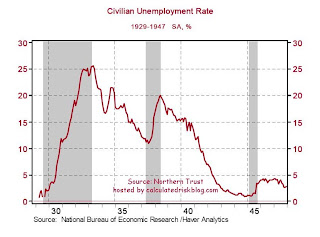by Calculated Risk on 1/11/2010 10:55:00 PM
Monday, January 11, 2010
The Depression of 1948?
It is always nice to be mentioned. Henry Blodget called the graph comparing the percent job losses in post WWII recessions "The Scariest Jobs Chart Ever"1. And then Glenn Beck mentioned the graph too, but ... uh, the Depression wasn't in 1948!
If we had the data, the percent job losses during the Great Depression (in the '30s) would probably have been 20% or more - far worse than the current employment recession. It was the Great Depression that led to the expansion of the BLS program to track employment. From the BLS:
With the deepening economic crisis in 1930, President Herbert C. Hoover appointed an Advisory Committee on Employment Statistics, which recommended extension of the BLS program to include the development of hours and earnings series. In 1932, the U.S. Congress granted an increase in the BLS appropriation for the survey. In 1933, average hourly earnings and average weekly hours were published for the first time for total manufacturing, for 90 manufacturing industries, and for 14 nonmanufacturing categories.
During the Great Depression, there was controversy concerning the actual number of unemployed people; no reliable measures of employment or unemployment existed. This confusion stimulated efforts to develop comprehensive estimates of total wage and salary employment in nonfarm industries, and BLS survey data produced such a figure for the first time in 1936.
 Click on graph for larger image in new window.
Click on graph for larger image in new window.Although there is some data on unemployment during the Great Depression, it is based on very rough estimates.
As an example, this graph from Northern Trust shows an estimate of the unemployment rate from 1929 through 1947.
 And here is a repeat of the "scariest chart ever".
And here is a repeat of the "scariest chart ever".Even after the benchmark revision is added next month, the job losses for the current recession as a percent of peak employment are only about one fourth of the losses in the Great Depression.
1Note: The total jobs lost does not include the preliminary benchmark payroll revision of minus 824,000 jobs. (This is the preliminary estimate of the final benchmark revision that will be announced on February 5, 2010).


